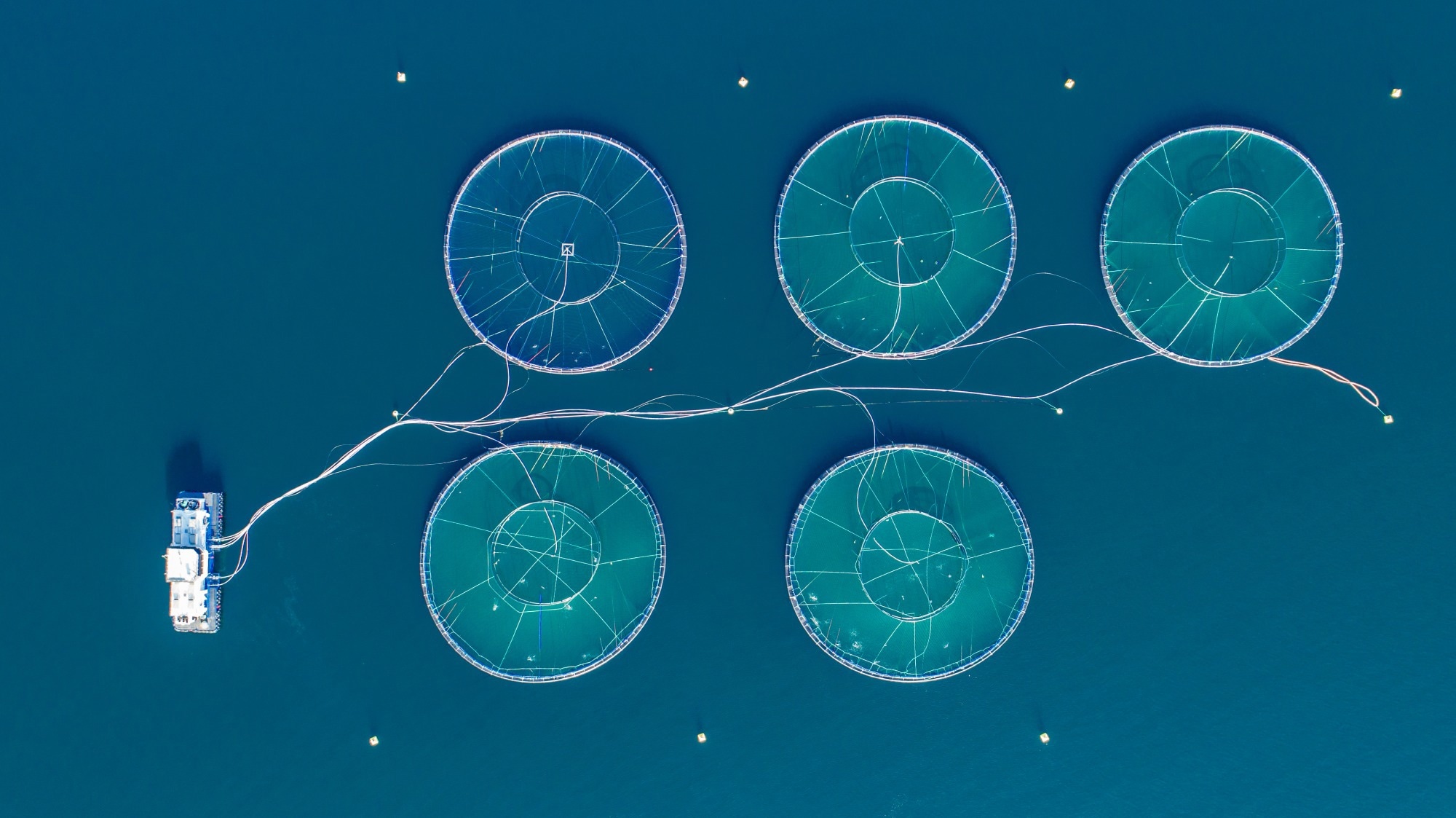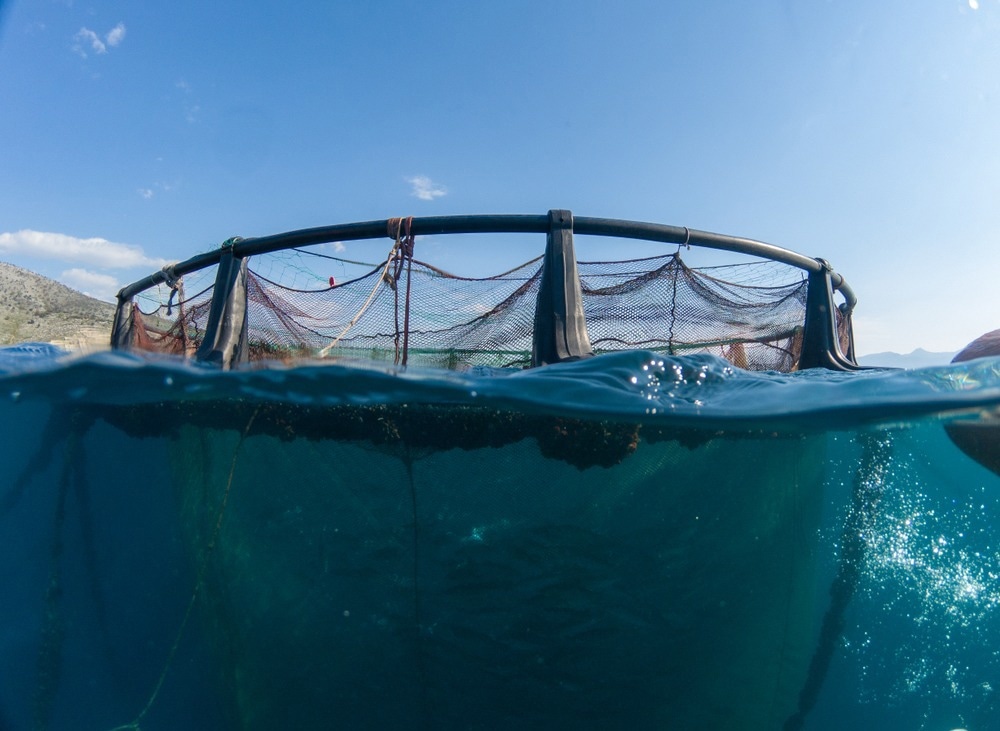Aquaculture is facing growing environmental and socioeconomic challenges. However, the implementation of rapidly developing autonomous, or ‘smart’, technologies, could provide key solutions to alleviate financial costs of labor, improve adaptive measures in response to environmental conditions, and increase productivity.

Floating aquaculture farms. Image Credit: Marius Dobilas/Shutterstock.com
Restructuring Aquaculture to Meet Demands for Food Using Emerging Technologies
Over half of global fish production originates from aquaculture. Aquaculture refers to the farming of aquatic organisms from shrimp and fish to seaweed and other aquatic plants. Since 1961, the annual growth rate of global consumption of fish for food was 3.1%, which is nearly twice as much as the growth rate of the world population during the same period.
The rate of increase in aquacultural production was also higher than that of other animal protein foods (meat, dairy products, milk, etc.), making aquaculture the fastest rising food industry in the world. The main reason fish has become a central source of food is that it represents better quality cheap protein in comparison to livestock, and aquaculture may therefore be a suitable alternative to livestock-dominated agriculture.
However, aquaculture faces many issues from the degradation of offshore fish stocks and marine pollution to the reduction in employees engaged in aquaculture that has been reported in recent years. Such practical problems warrant key changes in the industry, and many policies are aiming to restructure aquacultural sectors to address the environmental and societal issues arising from current practices.
Nonetheless, achieving structural changes is difficult in the face of increasing pressure on fisheries and aquaculture to meet rising food demands. Pressures are coming from within the sector, as internal competition is increasing and subsequently leading to higher resource depletion rates, and from external sources, such as the need for more urbanization and industrialization in coastal areas which generates higher competition for space and resources, and degrades the environment.
To overcome internal and external issues, recent developments in technology have made it possible to revolutionize traditional aquacultural practices by using emerging technologies. AI, machine learning and vision, the internet of things (IoT), and autonomous robots, are being integrated gradually, bringing aquaculture into digital intelligence.
Floating ‘Intelligent’ Farms of the Future
The integration of ‘intelligent’ technologies has accelerated the development of many sectors from industrial production to agriculture and aquaculture. The use of AI, machine learning, autonomous vehicles, or machines alleviates pressure on the labor force, provides tools for identification and analysis in real time, and can use big data analysis to improve decision-making on varying spatiotemporal scales.
For aquaculture, ‘intelligent’ technologies can also use multi-scenario analyses, integrate weather and environmental data, and monitor farming facilities, all in cost-effective ways. Using such technologies can help address some of the ecological and structural challenges aquaculture is currently facing, which are predicted to worsen in the coming decades.
Already, examples of autonomous fish farms are emerging around the world. In 2019, Norway successfully established the first offshore submersible fish farm in the Arctic Ocean that uses automated technologies to farm salmon. This farm has pens controlled remotely and is equipped with sensors detecting changes in environmental conditions from ocean currents to dissolved oxygen. Data from the fish pens are collected automatically and uploaded via wireless communication to a database, and the entire system is designed to withstand storm conditions, allowing it to endure in such harsh settings.
Such farm systems based on technological autonomy are considered to be a key to solving some of aquaculture’s challenges. Sensing and analyzing data represents the first step, but further technologies are being designed including robots, for example in a study by Ohrem et al. (2020), the authors describe a robot designed for fish husbandry that can film and analyze fish behavior as well as feed and harvest the fish.
Other robots are also being designed to monitor and patrol the underwater pens, and clean and repair fish nets, which would further improve the autonomy of such farms. Eventually, such intelligent fish farms may replace manual labor and optimize the use of fishery resources in a data-driven way to achieve efficient, green and smart aquaculture. However, despite the extensive potential and rapid development, many issues limit the progress of smart fish farms.

Aquaculture. Image Credit: A Daily Odyssey/Shutterstock.com
Challenges, Limitations, and Prospects to Autonomous Aquaculture
A 2021 review by Wang et al. describes the potential for autonomous aquaculture and highlights the difficulties associated with implementing such technologies. Authors categorize intelligent aquaculture into four types: pond-type intelligent fish farm, land-based factory-type intelligent fish farm, cage-type intelligent fish farm, and intelligent marine ranch. Although each facility type would have its own challenges on spatial and temporal scales, overarching issues are the most pressing.
First, the authors highlight how current environmental sensors are susceptible to surface attachment of the biological elements and have poor reliability of online measurement, resulting in most sensors having a short life span and low ‘intelligence’ capacity. Second, many systems suffer from unstable network transmission to the internet, which brings difficulties to back-end data processing and intelligent data analysis. Finally, the authors advocate for the use of flexible and accurate systems to improve big data acquisition as the biodiversity of aquatic animals and the complexity of their growing environment in intelligent fish farms pose challenges to data acquisition.
Further limitations to the intelligent floating fish farms were discussed by Utne et al. in 2018, who presented work related to the autonomous underwater operations in Norwegian aquaculture. The authors discussed the strengths of autonomous robots before discussing the different levels of autonomy involved in aquaculture, including details on operator dependency, communication structure, human-machine interface, an online risk management system, intelligence, planning functionalities, and mission complexity.
The fish feeding systems in this study were on low-level autonomous systems controlled remotely from a feeding barge. Further operations such as facility inspection by robots are advancing this stage of autonomy, yet the majority of farming operations remain manual, and no systems exist yet that can be described as highly autonomous. Looking forward, autonomous aquacultural operations remain reliant on advances in intelligent technologies, but with the speed of current development, aquaculture could rapidly reach goals of autonomy on small spatial scales.
Sources:
- Mallonee, L. (2020, February 18). Floating Farms Point the Way to Alternative Food Ecosystems. Wired. https://www.wired.com/story/floating-farms-global-food-ecosystem/
- Ohrem, S. J., Kelasidi, E., & Bloecher, N. (2020). Analysis of a novel autonomous underwater robot for biofouling prevention and inspection in fish farms. 2020 28th Mediterranean Conference on Control and Automation (MED). https://doi.org/10.1109/med48518.2020.9183157
- Probabilistic Safety Assessment and Management, & Utne, I. B. (2018, September). Reducing risk in aquaculture through autonomous underwater operations.
- Smart Floating Farms. (2022). Smartfloatingfarms.
- Wang, C., Li, Z., Wang, T., Xu, X., Zhang, X., & Li, D. (2021). Intelligent fish farm—the future of aquaculture. Aquaculture International, 29(6), 2681–2711. https://doi.org/10.1007/s10499-021-00773-8
Further Reading
Last Updated: May 13, 2023